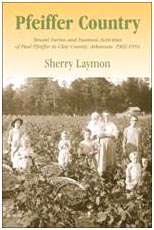The history of agriculture in the American South seems oversupplied with stories of tragedy and failure. In Arkansas, numerous families recall hard times of poverty and displacement, especially during the Great Depression of the 1930s and the “Great Depopulation” of the countryside that accelerated during the 1950s. In northeast Arkansas’s Clay County, one man, Paul Pfeiffer, took a different approach to the development of the land he owned and toward the tenant families who worked his fields. He often provided two-story homes, large barns, corn cribs, and other buildings at a single farmstead. He wanted his tenants to succeed and planned to sell them the land they worked at an accommodating price with reasonable financial arrangements. Pfeiffer did not try to trap his farmers in a cycle of endless debt and unremitting exploitation. Surprisingly his most active decade for these enlightened policies, 1925 to 1935, coincided with some of the worst years for American agriculture in the twentieth century. One hundred twenty-nine farm families worked for him during this time, and he did not alter his benevolent philosophy as the national economy spiraled downward.
Sherry Laymon applies her multiple talents as a scholar, writer, and artist in examining Paul Pfeiffer and his contributions to Clay County. She knows the old buildings, especially the houses and barns, that Pfeiffer placed on his farms. With the aid of former tenants, she has sketched these structures and recreated their floor plans. She also has examined the financial records of Pfeiffer’s enterprises and found a remarkable story of business acumen and humane generosity in hundreds of warranty deeds, sales documents, and other transactions. She has done numerous interviews, read dusty newspapers, and compiled statistical evidence. Most tellingly, she knows the story of this land and how it became a place for extensive farming only after its swamps were drained and its timber cut. Paul Pfeiffer accelerated this process when he began purchasing Clay County acreage in 1902. Here was a midwestern businessman, fresh from St. Louis, who saw the possibilities of raising crops on previously untilled soil. A new man in a new place looking for economic opportunity, he had not come to some far western locale, but to the northern reach of the Mississippi Delta. After a few years, he brought his wife, Mary, and their children to the small town of Piggott. They had relocated to a remote, underdeveloped region down river from St. Louis that for some could still be called a frontier.
One daughter, Pauline, only lived in Piggott for two years before going off to college in 1915. She corresponded often with her mother and when Pauline lived in Paris later on, she became Ernest Hemingway’s second wife. The famous American author regularly visited the Pfeiffer home in Piggott. Throughout the 1930s, Hemingway spent many weeks with his in-laws. Local families remember these sojourns, but their occasional sightings of the great writer have not obscured their even brighter memories of his father-in-law. Paul Pfeiffer did not join Hemingway for hunting trips out west and only fished with him once off the Florida Keys. By remaining in Piggott during the depths of the Great Depression, Pfeiffer’s generous acts helped numerous individuals in these hardest of times. For example, one story has him hiring men to paint his home time and time again to provide some form of useful work. The layers of paint uncovered in the later restoration of the family home as a museum indicates the truth of this legend.
Sherry Laymon well understands both Paul Pfeiffer and Clay County where he remains so well respected. When a scholar of Laymon’s ability looks so closely at a life, the results do not always match the public reputation. Yet after her examinations, Paul Pfeiffer remains a good man who did many good deeds. This excellent study is an appropriate recognition of a very fine life. Readers will benefit greatly from learning about Paul Pfeiffer and his vision for improving one part of Arkansas in the first half of the twentieth century.
Clyde A. Milner II
Arkansas State University

